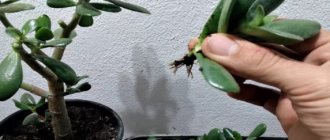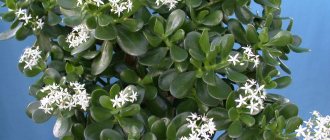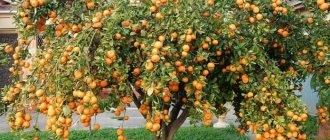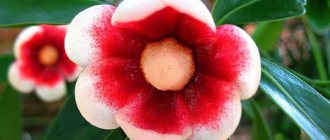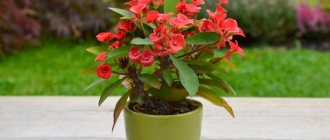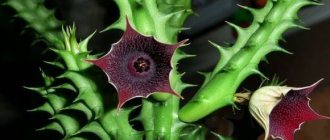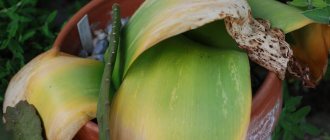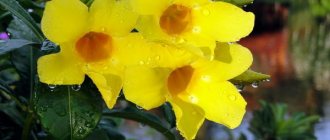- Description of the money tree Crassula and its types
- Why is the Crassula called the money tree?
- Conditions for flowering Crassula
- Watering and feeding the money tree
- Planting and replanting a money tree at home
- Soil and pot for money tree
- How to care for a money tree at home
- Money tree care problems
The money tree is a very decorative and unpretentious succulent, widespread in indoor culture. Caring for it does not take much time. Reproduction of this plant is also not difficult. Even a novice gardener can do this. Having an adult, overgrown specimen, you can easily and quickly get many young money trees.
Crassula ovata: photo, varietal diversity, home care: (read more)
The indoor perennial comes from the countries of the Southern Hemisphere, so it prefers the sunny side and dry soil.
In the article we will look at ways to propagate a money tree at home, and what methods exist for this. How to properly transplant a money tree (crassula) into another pot, and how to properly care for crassula sprouts at home.
Description
Crassula, also known as Crassula, or money tree, belongs to the large Crassula family. In its natural environment, this attractive succulent can be found in the tropical mountainous regions of Madagascar and Africa. Today, more than 300 types of crops are known, but at home, as a rule, oval crassula is grown. And it is this variety that is called the money tree.
This plant reaches up to 1.5 meters in height. Its thick trunk and numerous shoots are densely covered with dense, glossy oval-shaped leaves. In appearance they resemble emerald coins, which is actually why the plant got its second name.
There is a misconception that the money tree does not bloom when grown indoors. But this is not so, it’s just that only adult plants, over 10 years old, produce buds.
Crassula in the interior
A properly formed Crassula has the appearance of a small compact tree with a lignified brown trunk, the thickness of which depends on the age of the plant.
Adult specimens usually grow 1-1.5 m, but much taller plants are also found (up to 3 m).
After pinching, the branches grow greatly in width, forming a spreading crown with a large number of rounded leaves of a fleshy and plump texture. It is because of the shape of the leaf that the plant was dubbed the “Money Tree”.
The leaf color can be green or silver-blue. To form a beautiful crown, only one plant should grow in a pot.
It blooms very rarely in indoor culture. The first buds can form after 8 - 10 years of life . Small, star-shaped flowers are collected in small panicles. The color is white, pink or yellowish.
In the interior, the “Money Tree” looks very impressive - a smaller copy of huge trees involuntarily attracts the eyes of guests.
How to care at home
The money tree, like most succulents, has an unpretentious nature. But still, this plant needs to be provided with minimal care, which consists of the following agrotechnical measures:
- regular but moderate watering;
- periodic application of fertilizers;
- pruning and crown formation;
- planned transplant;
- prevention of diseases and pests.
In addition, it is necessary to maintain a certain temperature, humidity and lighting in the room that is suitable for this indoor plant - the money tree. How to care for a flower is described in more detail below.
Watering the money tree
Great news for those who always forget to water their flowers and plants: the money tree is not a big fan of moisture.
- In the spring and summer, we visit the plant with a watering can 1-2 times a week, focusing on the drying out of the top layer of soil;
- In autumn and winter, one watering per month is sufficient.
Money trees don't like spraying as much as deciduous plants. Instead, it is better to wipe the leaves: due to their density and shape, a lot of dust can accumulate on them.
Choosing a place for a flower
Crassula (money tree), the care of which we are discussing, is a light-loving crop, but direct sunlight is contraindicated for it. Therefore, when choosing a place for a plant, give preference to an eastern or western window sill. As a last resort, you can keep Crassula near the south window. But here, do not forget to shade the plant from the midday rays of the sun, otherwise the foliage will get burned, which will negatively affect the decorativeness of the tree.
But in the north, the flower will suffer from a lack of sun, and here it will not be possible to grow an attractive crop without illumination with a phytolamp. In addition, the flower may need additional artificial lighting in winter when the weather is cloudy. If you don’t have a phytolamp, then at least move the flower closer to the window.
Reproduction
Crassula propagates in warm weather by shoots, leaf cuttings and seeds. The cuttings should be planted immediately in the prepared soil to a depth of at least 5 cm, after wilting for two days .
There is another way (though it is longer, but nevertheless reliable), simply put the shoots in water until the roots appear, and then you should plant the cuttings with roots in pre-prepared soil.
Landing dates
There is a direct pattern between when a plant was planted and its flowering. If you plant a cutting in the spring in April or March, your tree is much more likely to bloom than a cutting planted in midsummer in July.
Propagation by seeds
If you decide to grow a money tree from seeds, then they (the seeds) should be placed in clay pots with holes in the bottom so that air circulates well, and covered with glass or cellophane. Every day, the seed pots need to be ventilated for half an hour and sprayed with water as the soil dries. In about a couple of weeks, sprouts should appear.
What temperature is suitable for the plant?
Money tree is a heat-loving crop, but the plant does not tolerate heat well. Therefore, try to maintain the temperature in the room with the flower within +20...+25 °C. If possible, take Crassula out to the balcony or garden in the summer. This will only work to your advantage. But choose places protected from sharp gusts of wind and direct sunlight.
In winter, it is advisable to create a dormant period for the tree with cooler conditions. And at this time it is better to move the flower to a room with a temperature of +10...+15 °C. If you do not have such a room, then move the pot closer to the window, where it is always cooler, but make sure that the flower does not get hot air from radiators or heating devices. From such a “neighborhood” the tree trunk will become very long and the leaves will fall off, which will negatively affect the decorativeness of the crop.
Another important rule on how to care for a money tree is to regularly ventilate the room. After all, without an influx of fresh air it will not be possible to grow a healthy plant. Therefore, do not forget to ventilate the room at any time of the year. But keep in mind that Crassula does not tolerate temperature changes and drafts, so during this procedure, take the pot to another room.
Bloom
Also check out these articles
- Grouse in a natural garden
- The benefits of weeds for the land and garden
- Magic Lessons
- Fertilizer and feed additive Blood meal
Crassula does not bloom often, the flowers are white, collected in inflorescences. It is believed that plants that have reached 5 years of age bloom.
Flowering occurs in winter and under certain conditions. From summer until mid-fall, keep the plant on the balcony or outside. Do not overwater, feed with fertilizers for cacti, constantly ventilate and remove old leaves.
This is what a blooming crassula looks like
Flowers appear at the end of autumn or winter. They are white or light pink in color, small in size with curled petals and collected in inflorescences. They have a strong sweetish smell.
How to water a flower
Regular but moderate watering is one of the basic rules of home care. A living tree is a succulent, which means it can withstand drought more easily than waterlogging. But complete drying out of the soil can be detrimental to Crassula. Therefore, be responsible when watering.
In summer, when the weather is hot, moisten the soil every 3-4 days. In winter, reduce watering to a minimum. If you keep the plant in a warm apartment, then 1-2 waterings per month will be enough. How do you know exactly when it’s time to moisten the soil? Check it, and if the substrate has dried to a depth of 3-4 cm, then water the flower.
At any time of the year, for hydration, use exclusively rain or melt water, the temperature of which is 2-3 degrees higher than in the room. In extreme cases, tap water will do. But before watering, it needs to be filtered and left for 3-4 days.
Crassula easily tolerates the dry air of apartments; it does not need spraying. But still, the leaves of the crop need to be regularly wiped with a damp cloth to remove dust. Otherwise, the dirt will block the access to fresh air, which will have a bad effect on the health and decorativeness of the tree.
And it is also sometimes useful for the plant to take a warm shower. But during this procedure, make sure that moisture does not get into the soil. Therefore, be sure to wrap the pot in plastic. To prevent the tree from getting too cold, return it to its usual place after a shower only when all the liquid has drained.
Learning to feed the fat woman
One of the basic rules on how to care for a money tree is to regularly fertilize it. The fact is that Crassula quickly draws nutrients from the soil, and without feeding it does not have enough strength to grow green mass. Therefore, from the beginning of spring to the end of summer, pamper Crassula with fertilizers once a month. And use mineral compositions for cacti as fertilizers. In addition, sometimes you can use foliar fertilizers by spraying the preparations on the foliage of the tree. But in this case, use a weakly concentrated solution of the drugs.
In winter, the plant does not need feeding. But if it is very weak, then fertilize it once a season. At any time of the year, apply preparations only to moist soil. Otherwise, the compositions will burn the delicate roots of the flower.
Pruning and crown formation
With proper care at home, the money tree flower will grow well, and it is very important to shape the crown so that it does not grow into an ugly bush. First of all, do not forget to turn the plant in different directions towards the light. This way it will develop evenly and bald spots will not form on it.
In addition, in order for the plant to produce more shoots, you need to pinch its top. Moreover, this should be done when 3-4 pairs of leaves appear on the young tree. In the future, pinching should be done for each shoot, when 4 pairs of leaves are formed on them.
If you purchased an adult tree, then you can shape its crown by pruning. Carry out this procedure in the spring, and only with sharply sharpened and disinfected instruments. After trimming, be sure to sprinkle the cut areas with crushed activated charcoal or charcoal.
Houseplant care
The money tree is ideal for growing indoors, as it can withstand dry air and lack of care for a long time.
What is the correct name?
Crassula, or Crassula (from the Latin crassula - “thick”) is a large family of succulent plants. There are about 300 species of Crassula in nature, most of which grow in southern Africa. Crassula ovata (Crassula ovata) is usually grown indoors . It is this variety that is commonly called the money tree.
What does it look like?
Crassula is a fairly large evergreen shrub. In nature, it can grow up to 1.8 m; at home, its height is about 50 cm. The plant has a thick, knotty trunk with a diameter of up to 20 cm and highly branching stems.
The leaf blades of the plant are glossy, fleshy, bright green, attached to short petioles located opposite each other. The length of the leaves is on average 5 cm. They have an ovoid shape that resembles coins, which gave the Crassula its second name. The money tree can form umbrella inflorescences consisting of white flowers that look like stars .
Where to put it, how to light it in winter?
The fat woman loves intense lighting and can even be in direct sunlight. With a lack of light, the leaves of the money tree become dull and the stems take on an elongated appearance.
Important! Young varieties of plants exposed to direct sun can change the color of the foliage from green to brown. To avoid this, it is necessary to protect the tree from the afternoon sun with a curtain or blinds.
It is best to place the container with Crassula near the south, southwest or southeast windows. If you install the plant near a north window, you will need an additional light source (for example, a phytolamp). Artificial lighting may also be required in winter.
In order to form a symmetrical crown, it is worth turning the tree from time to time to the light source in different directions.
Watering and fertilizing
Crassula requires infrequent but regular watering . Excess moisture is detrimental to succulents because it causes root rot.
- In summer, the watering procedure is carried out once a week and less often as the soil dries out.
- In autumn and spring, the frequency of watering is reduced to once every 2-3 weeks.
- In winter, when the plant is dormant (from November to February), watering is reduced to once a month. If the fat plant is located in a cool room during the resting phase, it does not need to be watered at all.
When watering, you should follow a number of rules:
- It is necessary to use water at room temperature. Rainwater is best suited; tap water will need to be softened before watering (let it sit for 2-3 days or add citric acid to it).
- The container with the flower must have drainage holes. The water that has accumulated in the pan after watering must be drained.
- The need for watering is determined by the condition of the soil: it must be dry to a depth of 3 cm.
- The plant does not require spraying, but its leaves must be periodically wiped from dust.
- You should moisten the soil around the succulent and avoid watering it from above.
Important! If the soil does not dry out for a long time between waterings, this indicates an incorrect selection of soil composition or pot size.
Feeding of the fat plant is carried out during the growing season - from March to September, once a month. The plant is fed after watering with specialized fertilizers for succulents or cow manure (it is diluted with water in a ratio of 1:10). During the dormant period, the plant does not need to be fertilized. If the plant is replanted annually, fertilizing may not be necessary .
About the rules for watering Crassula in the video:
Temperature and humidity
Since the Crassula is native to South Africa, it prefers dry and warm conditions. In summer, the plant will feel good at a temperature of 22–25 °C. In winter, it is advisable to provide it with a lower temperature (from 10 to 15 °C).
Since the tree loves fresh air, in the summer it is recommended to take it out to the loggia or garden. It is also important to regularly ventilate the room where the plant is located. But drafts are contraindicated for him.
Humidity is not an important parameter when growing a money tree . It, like other succulents, is able to accumulate moisture to survive in dry air conditions (for example, during the heating season).
Pruning and crown formation
Crassula pruning is practiced for the following purposes:
- giving the crown an attractive appearance;
- the formation of thicker stems;
- to avoid side branches growing too much (their weight may cause the tree to break).
The pruning procedure is carried out at the end of winter - beginning of spring before entering the growth phase.
For young specimens, pinching the tops is practiced, which promotes the formation of a larger number of shoots. They begin to do this when 4 pairs of leaves form on a young plant. Subsequently, each shoot is pinched in the same way.
The crown of an adult tree is formed in different ways:
- cut long creeping stems and remove lower leaves and branches;
- The side shoots are allowed to grow to form a thick trunk, and then they are removed (to obtain a bonsai-style tree).
Basic rules for crown formation:
- Do not cut off more than a third of the branches at a time;
- do not touch the main stem of the tree;
- pruning is carried out with sharply sharpened tools;
- The cut areas should be sprinkled with crushed activated carbon.
In the video about the rules of crown formation:
Transfer rules
If you provide the flower with proper care, the money tree will quickly grow and it will become cramped in the old pot. Therefore, it is impossible to do without a transplant. For young plants, it is advisable to carry out this procedure once every two years. Adult fatworts are replanted less frequently, approximately once every 3-4 years.
Start this activity in early spring, then the plant will more easily withstand the stress of replanting and will take root faster. The money tree has shallow roots, so choose a shallow pot with a diameter that matches the size of the crown. In addition, give preference to heavy and stable flowerpots so that the plant does not collapse under its own weight. For this reason, you should not plant flowers in plastic containers.
As for the soil, the plant prefers light, breathable soil with a neutral reaction. A store-bought mixture designed for succulents will do. If you want to make the substrate yourself, then mix turf soil, humus, sand and leaf soil in a ratio of 4:1:1:1. Be sure to disinfect this mixture so that the plant does not suffer from microbes and pests living in the soil. To do this, heat the substrate in the oven or hold it over steam.
How to replant a plant
Carry out a money tree transplant, which we will look after at home, as follows:
- Place a 3 cm thick layer of drainage on the bottom of the new pot. Expanded clay, pebbles or broken brick will do. Cover the drainage with a centimeter layer of soil.
- Carefully remove the tree from the old container. To make this easier, water the flower 3-4 hours before the event.
- Lightly shake the earthen ball and inspect the roots of the plant. If necessary, cut out damaged and rotten shoots, not forgetting to treat the cut areas with crushed charcoal.
- Place the flower in the center of the pot, slightly straighten the roots and fill the voids with soil.
- Water the soil and move the plant to a bright place out of direct sunlight.
How to care for a money tree flower after transplantation? At first, regularly loosen the soil to a shallow depth. So, you will increase air access to the roots, which will improve the survival rate of the crop.
How to grow a money tree with a thick trunk
It will be possible for a young individual to make the stem wide; an adult crop does not lend itself well to such manipulations. A thick trunk is obtained by growing long branches. Long shoots have powerful bases. After the stem has grown to a sufficient thickness, the length is removed. The leaves at the bottom of the trunk are also removed. The sections are treated with coal and ash. The distance between the soil and the cut branches should remain small; you can add soil. The succulent will produce additional roots and begin to thicken the stem.
Forming a Crassula at home
Winter is the best period for thickening the trunk. Pruning is carried out in February-March. The top buds on the branches should be pinched with tweezers or clean fingers. Young shoots are torn off with a rotational movement, preventing damage to the branch. Experts also recommend cutting off the last 2-3 leaves. The growth of the crown will be delayed, and the plant’s forces will be directed toward enlarging the trunk.
If large branches spoil the appearance of the crop, they are removed. In advanced situations, they act according to step-by-step instructions: the stem is cut at the required height, forming a right angle above the age ring around the trunk, the cut is treated with crushed coal.
Propagation by cuttings
Crassula reproduces well at home; if desired, you can grow a large collection of these attractive plants. And the easiest way to do this is by cuttings, and even a novice gardener can cope with this activity.
Start propagation in early spring, when the plant begins its growing season. For cuttings, choose apical, strong shoots, and cut them so that each piece has several leaves, and their length reaches 10 cm. Dry the branches in the air for 24 hours, and then plant them in containers filled with nutrient substrate. Occasionally spray the soil with warm water from a spray bottle, being careful not to get moisture on the plants. Rooting will take 1-2 weeks. When the cuttings are strong enough, transplant them into individual pots.
If you don't want to mess with the soil, you can root the plants in water. How to do it? Remove the lower leaves from the cutting and place it in a half-filled glass of water. Be sure to add any growth stimulant to the liquid, such as Kornevin or Zircon. Keep the plant in partial shade and add water as needed. Rooting in this case will take up to two weeks.
Landing
If you want to grow a “Money Tree” yourself, you can use two planting methods:
Planting a plant with seeds. Use small, wide pots with good drainage holes. Seeds are placed in them, lightly sprinkled with soil, and a kind of greenhouse is created using a transparent vessel. Seeds require daily ventilation and soil moisture. In just half a month, sprouts may appear.
- Planting by cuttings. A branch is cut from an adult plant and placed in water. After the roots have formed, the cuttings can be planted in cactus soil or regular soil. The cuttings will take root when planted immediately in the ground.
Growing from seeds
This method is quite labor-intensive and requires a lot of time and certain knowledge. However, if you want to grow a new rare variety, you can experiment.
Start the event in the spring. First, prepare shallow containers and make several drainage holes in them. Fill the containers with a disinfected mixture or leaf soil and sand in a ratio of 2 to 1. Distribute the plant seeds evenly over the substrate and sprinkle them with a layer of sand 0.5 cm thick. Sprinkle the planting with water and cover with polyethylene or glass.
Place the improvised greenhouse in a bright and warm place. Ventilate the planting regularly and, if necessary, spray the soil with warm water from a spray bottle.
The first shoots can be expected within 2-3 weeks. When the seedlings become stronger, plant them in individual pots filled with a mixture of leaf soil, sand and turf soil (2:1:1). How to care for money trees in the future? Keep the seedlings in a bright place out of direct sunlight. Water the soil occasionally, not allowing it to dry out completely. When young trees reach 7 cm in height, transplant them into pots with substrate as for adult plants, and provide the crops with normal care.
Planting and propagation
Rooting cuttings in water
A simple and unsophisticated method that gives good results, since the root system will already be developed. Important: sometimes with this method the roots can rot, so be careful.
- A healthy shoot is cut off from an adult tree, dried a little and placed in water (make sure that the leaves do not touch the water).
- We wait 2-3 weeks for the roots to appear, changing the water once a week.
- Take a pot of suitable size.
- Add enough drainage stones.
- Fill the pots with soil (a ready-made soil mixture for cacti and succulents is ideal). This seemingly poor and dry soil mixed with pebbles and sand is a familiar and comfortable environment for succulents.
- We install the cutting, dig it in and evenly add soil to the desired level (do not bury it).
- Water and place in the prepared place.
- In the following days, do not overwater the soil; let it remain slightly dry.
- We wish our little sprout good luck!
Rooting cuttings in soil
A money tree shoot rooted in the ground immediately remains in its house, without the need for additional planting, which is extremely convenient. We proceed like this:
- We cut a sprout 10-15 cm long from an adult tree.
- Prepare the pot by filling it with drainage and soil.
- We place the process so that it does not fall over.
- Sprinkle with soil evenly.
- Water (in this case, you can also use a special solution to form roots).
- Place the planted cuttings in a bright and warm place.
- We are waiting for new leaves to appear (this is a signal that the roots have successfully begun to grow).
Leaf propagation
The tenacious and unpretentious money tree gives us the opportunity to get new plants even from leaves! Our actions:
- Choose a leaf (oddly enough, a slightly wilted one is best);
- You can cut off a healthy leaf and leave it in the air for a day;
- We lower the leaf into the water with a half-centimeter cut;
- Some people add special preparations to the water to quickly form roots;
- We wait for the roots, and then we transplant the leaf into the ground.
The cut leaf can be immediately rooted in the soil.
- Place the leaf cut side down in a glass or pot;
- We monitor the humidity, do not overwater;
- For faster growth, you can install a mini-greenhouse in the form of a jar, cellophane or a transparent plastic cup. Important: the greenhouse must be opened every day for ventilation;
- Having noticed the development of the future tree, we clean the greenhouse and care for the plant as usual.
You can learn more about the propagation of crassula by leaf in this video.
Diseases and growing problems
With proper care, an indoor money tree almost never gets sick. But if you regularly violate the norms of agricultural technology, the fat woman will begin to be capricious. The following problems may arise with it:
- Leaves become discolored and wilt. Typically, this phenomenon occurs in winter and is caused by overwatering. To correct the situation, normalize moisture and the plant will recover.
- The tree is shedding its leaves. This phenomenon is caused by insufficient watering or moistening with cold water. How to care for a money tree flower to correct the situation? Normalize irrigation, and do not forget to water the plant with warm water, and the fat plant will restore the splendor of the crown.
- The leaves lose their shine, darken and wrinkle. This is how the plant reacts to severe drying out of the soil. Immediately water the tree, remove damaged leaves and then normalize irrigation.
- The shape of the tree is greatly deformed, and the plant loses its decorative effect. This phenomenon is caused by a lack of light. Move the pot closer to the window, or arrange additional artificial lighting. And over time, the fat woman will restore its decorative shape.
- White or brown spots form on the leaves. This suggests that the fat woman has contracted a fungal disease. Immediately treat the plant with a fungicide and, if necessary, replant it in new soil.
How to resuscitate?
The peculiarities of the “Money Tree” as a succulent plant allow you to avoid the death of damaged specimens.
When shedding leaves, loss of turgor, stretching of branches and other problems associated with improper care, it is enough to remove the damaged areas.
It is necessary to create comfortable conditions for the plant to return to its original appearance.
But when root rot is discovered on the Money Tree, drastic measures are required to revive it. Infected roots are removed from the plant, treated with an antiseptic and replanted in new soil. If all the roots are dead, then the top of the tree is cut off and rooted, as with cuttings. This is the only way to save the plant.
Getting rid of pests
As a rule, the juice of the Crassula repels insects. But with frequent mistakes in care, the money tree weakens and becomes vulnerable to various pests. Flower growers often encounter the following parasites:
- Spider mite. This parasite can be recognized by the white lumps that form on the leaves and shoots of the plant, as well as by the sticky web. If you notice a pest, treat the tree with soapy water twice, maintaining an interval of 5-6 days between treatments. If this does not help, then spray the flower with an insecticide, such as Fitoverm or Actellik.
- Mealybug. This parasite leaves a white coating and cotton wool-like lumps that can be found in the axils of leaves. A soap solution helps get rid of insects. If the colony of parasites is too numerous, then it is better to treat the flower with the insecticide “Aktara” or “Aktellik”.
- Shield. These insects can be seen with the naked eye, and they look like brown raised spots. Scale insects will have to be removed manually using a cotton swab dipped in kerosene or alcohol. After this, it is necessary to treat the plant with a soap solution. And such procedures will have to be repeated until the pests are completely destroyed.
Provide good care to the money tree, and your pet will be spared any parasites.
Types of Crassula, all kinds of varieties and photos
We recommend reading our other articles
- Insecticide Biotlin
- Thrips on plants
- 5 common mistakes in caring for indoor flowers
- Peperomia
The most common type is the oval fat plant; it stands on almost every housewife’s windowsill. The leaves are dark green with red edges. The aerial roots are white, but turn brown with age. The flowers are snow-white or pinkish.
Crassula oval
Tree Crassula differs from it in having light, large, rounded leaves.
Crassula arborescens
Silver Crassula has silver-gray leaves.
Crassula rock is not a large plant, no higher than 25 cm. When grown in hanging pots, the shoots hang down intricately. Its leaves have a red coating and a border. The leaves are arranged in pairs and grow together at the base. Pink flowers.
Rock Crassula
Another unusual species is the fringed crassula. It has a narrow trunk and triangular, egg-shaped leaves. As the temperature rises, the edges of the leaves turn bright red.
Crassula fringed
The smallest representative is the lycophyte, growing from 6 to 10 cm. Small leaves completely cover the trunk, arranged in 4 rows. The shoots simply break off and take root. The flower has yellowish, inexpressive flowers.
Tossyanka lycopodidae
Crassula tetrahedral has thin branches that spread along the ground in a pot. She has many aerial roots.
Crassula tetrahedral
Crassula shaggy is less common. Its leaves are covered with hairs, like violet leaves. You cannot spray this flower!
Crassula shaggy
Feng Shui lessons: making a lucky talisman out of wood
Crassula serves not only as a home decoration, because this flower purifies the air and kills germs, making the indoor microclimate healthier. And besides, according to the teachings of Feng Shui, Crassula brings good luck and wealth to the house. So this is not only a beautiful, but also a useful indoor plant (money tree). How to care for a flower to make it a lucky talisman? Follow these recommendations:
- To grow a money tree, use only strong and healthy seedlings.
- When planting the crassula, place eight coins of the same denomination at the bottom of the pot. Moreover, place them only with the coat of arms facing up.
- Carry out the landing itself on Wednesday, preferably on a waxing moon. This will increase the magical properties of the plant tenfold.
- Hang coins on the branches of Crassula, stringing them on red silk threads.
- Take proper care of the flower, because only plants grown with love bring good luck. Moreover, Feng Shui experts recommend watering the fat plant exclusively on Wednesdays. It is believed that on this day the plant is imbued with good luck, which it then shares with you.
Now you know everything about what a money flower is and how to care for it. Follow these recommendations, create comfortable conditions for the plant, and it will not only delight you with its decorative appearance, but will also bring wealth and good luck to your home.
